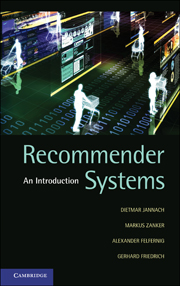Book contents
- Frontmatter
- Contents
- Foreword
- Preface
- 1 Introduction
- PART I INTRODUCTION TO BASIC CONCEPTS
- PART II RECENT DEVELOPMENTS
- 9 Attacks on collaborative recommender systems
- 10 Online consumer decision making
- 11 Recommender systems and the next-generation web
- 12 Recommendations in ubiquitous environments
- 13 Summary and outlook
- Bibliography
- Index
11 - Recommender systems and the next-generation web
from PART II - RECENT DEVELOPMENTS
Published online by Cambridge University Press: 05 August 2012
- Frontmatter
- Contents
- Foreword
- Preface
- 1 Introduction
- PART I INTRODUCTION TO BASIC CONCEPTS
- PART II RECENT DEVELOPMENTS
- 9 Attacks on collaborative recommender systems
- 10 Online consumer decision making
- 11 Recommender systems and the next-generation web
- 12 Recommendations in ubiquitous environments
- 13 Summary and outlook
- Bibliography
- Index
Summary
In recent years, the way we use the web has changed. Today's web surfers are no longer mere consumers of static information or users of web-enabled applications. Instead, they play a far more active role. Today's web users connect via social networks, they willingly publish information about their demographic characteristics and preferences, and they actively provide and annotate resources such as images or videos or share their knowledge in community platforms. This new way of using the web (including some minor technical innovations) is often referred to as Web 2.0 (O'Reilly 2007).
A further popular idea to improve the web is to transform and enrich the information stored in the web so that machines can easily interpret and process the web content. The central part of this vision (called the Semantic Web) is to provide defined meaning (semantics) for information and web services. The Semantic Web is also vividly advertised, with slogans such as “enabling computers to read the web” or “making the web readable for computers”. This demand for semantics stems from the fact that web content is usually designed to be interpreted by humans. However, the processing of this content is extremely difficult for machines, especially if machines must capture the intended semantics. Numerous techniques have been proposed to describe web resources and to relate them by various description methods, such as how to exchange data, how to describe taxonomies, or how to formulate complex relations among resources.
Information
- Type
- Chapter
- Information
- Recommender SystemsAn Introduction, pp. 253 - 288Publisher: Cambridge University PressPrint publication year: 2010
Accessibility standard: Unknown
Why this information is here
This section outlines the accessibility features of this content - including support for screen readers, full keyboard navigation and high-contrast display options. This may not be relevant for you.Accessibility Information
- 3
- Cited by
